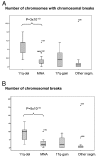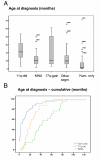High-risk neuroblastoma tumors with 11q-deletion display a poor prognostic, chromosome instability phenotype with later onset
- PMID: 20145112
- PMCID: PMC2840092
- DOI: 10.1073/pnas.0910684107
High-risk neuroblastoma tumors with 11q-deletion display a poor prognostic, chromosome instability phenotype with later onset
Abstract
Analysis of chromosomal aberrations is used to determine the prognosis of neuroblastomas (NBs) and to aid treatment decisions. MYCN amplification (MNA) alone is an incomplete poor prognostic factor, and chromosome 11q status has recently been included in risk classification. We analyzed 165 NB tumors using high-density SNP microarrays and specifically compared the high-risk groups defined by MNA (n = 37) and 11q-deletion (n = 21). Median patient age at diagnosis was 21 months for MNA tumors and 42 months for 11q-deletion tumors, and median survival time after diagnosis was 16 months for MNA and 40 months for 11q deletion. Overall survival (at 8 years) was approximately 35% in both groups. MNA and 11q deletion were almost mutually exclusive; only one case harbored both aberrations. The numbers of segmental aberrations differed significantly; the MNA group had a median of four aberrations, whereas the 11q-deletion group had 12. The high frequency of chromosomal breaks in the 11q-deletion group is suggestive of a chromosomal instability phenotype gene located in 11q; one such gene, H2AFX, is located in 11q23.3 (within the 11q-deletion region). Furthermore, in the groups with segmental aberrations without MNA or 11q deletion, the tumors with 17q gain have worse prognosis than those with segmental aberrations without 17q gain, which have a favorable outcome. This study has implications for therapy in different risk groups and stresses that genome-wide microarray analyses should be included in clinical management to fully evaluate risk, aid diagnosis, and guide treatment.
Conflict of interest statement
The authors declare no conflict of interest.
Figures




Similar articles
-
FISH analyses for alterations in chromosomes 1, 2, 3, and 11 define high-risk groups in neuroblastoma.Med Pediatr Oncol. 2003 Jul;41(1):30-5. doi: 10.1002/mpo.10313. Med Pediatr Oncol. 2003. PMID: 12764740
-
Age dependence of tumor genetics in unfavorable neuroblastoma: arrayCGH profiles of 34 consecutive cases, using a Swedish 25-year neuroblastoma cohort for validation.BMC Cancer. 2013 May 9;13:231. doi: 10.1186/1471-2407-13-231. BMC Cancer. 2013. PMID: 23656755 Free PMC article.
-
Gain of distal chromosome arm 17q is not associated with poor prognosis in neuroblastoma.Clin Cancer Res. 2003 Oct 15;9(13):4835-40. Clin Cancer Res. 2003. PMID: 14581355
-
Oligonucleotide microarray analysis of gene expression in neuroblastoma displaying loss of chromosome 11q.Carcinogenesis. 2004 Sep;25(9):1599-609. doi: 10.1093/carcin/bgh173. Epub 2004 Apr 16. Carcinogenesis. 2004. PMID: 15090470 Review.
-
11q deletion in neuroblastoma: a review of biological and clinical implications.Mol Cancer. 2017 Jun 29;16(1):114. doi: 10.1186/s12943-017-0686-8. Mol Cancer. 2017. PMID: 28662712 Free PMC article. Review.
Cited by
-
Segmental chromosomal alterations have prognostic impact in neuroblastoma: a report from the INRG project.Br J Cancer. 2012 Oct 9;107(8):1418-22. doi: 10.1038/bjc.2012.375. Epub 2012 Sep 13. Br J Cancer. 2012. PMID: 22976801 Free PMC article.
-
Control-FREEC: a tool for assessing copy number and allelic content using next-generation sequencing data.Bioinformatics. 2012 Feb 1;28(3):423-5. doi: 10.1093/bioinformatics/btr670. Epub 2011 Dec 6. Bioinformatics. 2012. PMID: 22155870 Free PMC article.
-
The microenvironment of human neuroblastoma supports the activation of tumor-associated T lymphocytes.Oncoimmunology. 2013 Mar 1;2(3):e23618. doi: 10.4161/onci.23618. Oncoimmunology. 2013. PMID: 23802089 Free PMC article.
-
Altered methylation of imprinted genes in neuroblastoma: implications for prognostic refinement.J Transl Med. 2024 Aug 31;22(1):808. doi: 10.1186/s12967-024-05634-5. J Transl Med. 2024. PMID: 39217334 Free PMC article.
-
Low DLG2 gene expression, a link between 11q-deleted and MYCN-amplified neuroblastoma, causes forced cell cycle progression, and predicts poor patient survival.Cell Commun Signal. 2020 Apr 20;18(1):65. doi: 10.1186/s12964-020-00553-6. Cell Commun Signal. 2020. PMID: 32312269 Free PMC article.
References
-
- Spitz R, et al. Favorable outcome of triploid neuroblastomas: A contribution to the special oncogenesis of neuroblastoma. Cancer Genet Cytogenet. 2006;167:51–56. - PubMed
-
- Spitz R, et al. Oligonucleotide array–based comparative genomic hybridization (aCGH) of 90 neuroblastomas reveals aberration patterns closely associated with relapse pattern and outcome. Genes Chromosomes Cancer. 2006;45:1130–1142. - PubMed
-
- Brodeur GM. Neuroblastoma: Biological insights into a clinical enigma. Nat Rev Cancer. 2003;3:203–216. - PubMed
-
- Schwab M, Westermann F, Hero B, Berthold F. Neuroblastoma: Biology and molecular and chromosomal pathology. Lancet Oncol. 2003;4:472–480. - PubMed
Publication types
MeSH terms
Substances
LinkOut - more resources
Full Text Sources
Medical
Research Materials
Miscellaneous

